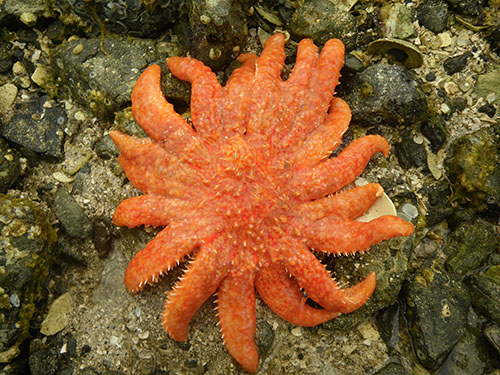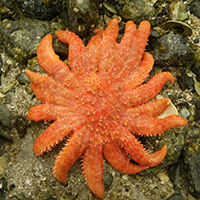— from Russel Barsh, KWIAHT Director —

A recent paper from the Harvell lab at Cornell University has attracted international media attention by claiming that the West Coast population of Sunflower Stars (Pycnopodia helianthoides) has declined dramatically in the past few years, presumably due to a warming ocean and wasting syndrome (SWS), and may be headed for extinction. Harvell’s data do show a steep decline in this species of starfish (Asteroidea) on the West Coast since the 2014 SWS epidemic, albeit far short of extinction, either regionally or globally. Her paper has nonetheless been amplified by science journalists and social media into proof of an imminent worldwide sea star apocalypse.
Indian Island was part of the original SWS study in 2014-2015, and at one stage Harvell predicted publicly that the sea stars at Indian Island would soon be “extinct.” On the contrary, my team has been observing and counting sea stars at Indian Island for ten years, and although two-thirds of them may have perished during the wasting epidemic, they rebounded in just two seasons, and in 2018 survived another, less virulent outbreak of the same disease. Harvell and I disagree about the methodology for counting sea stars at Indian Island, their numbers at Indian Island during the epidemic, and the lessons we can learn from what we observed. We also have different perspectives on the significance of disease in nature that have to do with time scales, and with processes in evolution.
The 2014 wasting event was not the first on the West Coast, but at least the third in the past fifty years. This is what we can expect from an aggressive pathogen. Its initial attack can be devastating, but if the victim is diverse genetically and widespread geographically there will be survivors, usually with some degree of resistance. The survivors repopulate the species, and the pathogen becomes less deadly—until it mutates in some way that overcomes the specific kind of resistance that survived its initial attack. It is extremely rare for disease alone to exterminate a single species, much less an entire Class of roughly 1,500 living species that has persisted on Earth for over 435 million years.
Think of the pandemics that have devastated human populations in the last millennium. The Black Death killed roughly half the population of Europe in the 14th century, but the other half survived and rebounded, despite numerous reappearances of the pathogen—which in fact is still among us, and responsible for periodic outbreaks. Although the “Spanish flu” killed some 50 million people in 1917-1918 it infected 500 million, or about one-third of our species at that time. Since 1918 we have suffered periodic outbreaks as the virus (which retreats to reservoirs in other vertebrate species such as birds) evolves new strains, and re-infects humans. Influenza has killed and debilitated vast numbers of people, but never come close to exterminating our species.
Indeed, this is one important reason for protecting genetic diversity in all of the species with which we share the planet. Diversity reduces the risk of dead-end pandemics. On the other hand, when people degrade and fragment habitats, we often reduce genetic diversity and make epidemics more deadly. Artificial production on farms or in hatcheries can also reduce diversity and facilitate pandemics. But the Asteroidea are free-living, and no one has shown that human activities (directly, or indirectly through climate change) have reduced their genetic diversity.
In the extremely short term of decades, we may witness dramatic changes in abundance and behavior of some sea star species, while in the long term of evolution—millions of years—it is highly improbable that all of the Asteroidea will disappear.
I fear that what is wasting away more swiftly than sea stars is the credibility of scientific institutions, as more researchers make premature sweeping claims, and take their claims to the press before their colleagues have had time to verify the underlying data and suggest alternate explanations. The “business model” that universities adopted a generation ago promotes a rush to the press, and rewards the broadest, most shocking (and thus newsworthy) claims—even if they lack support in the data or belie our understanding of basic processes in nature.
**If you are reading theOrcasonian for free, thank your fellow islanders. If you would like to support theOrcasonian CLICK HERE to set your modestly-priced, voluntary subscription. Otherwise, no worries; we’re happy to share with you.**









Thank you for being our watchdog for the health of our ecosystem, Russel. Your caution/suggestion that we need to maintain as much diversity as possible should be a guiding principle. In this era of media sensationalism, it is good to have a grounded local expert who can tell us the real story.
Great insight, as always, Russel!
I’m very pleased to read information from someone with critical thinking skills who is “on the front lines,” rather than from some academic theorizer with a political or polemical agenda.
Thank you, Russel.
Agreed. Insufficient peer review, half-hearted literature searches, poorly designed scientific studies, the tossing out of inconvenient negative data without mention, sweeping assumptions – I have had several older researcher friends and family including my dad, who was an editor for a geology journal, complain about the increase in relaxed standards. There weren’t as many journals way back when and, yeah, it was a bummer if your paper got rejected, but there was usually a very good reason, usually sloppy methodology, or faulty logic in the conclusion. It’s too easy to get sub-par scientific papers in print these days, way too easy.